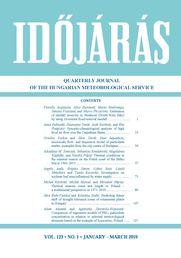IDŐJÁRÁS - angol nyelvű folyóirat
Vol. 123, No. 1 * Pages 1–133 * January - March 2019
 |
|
 letöltés [pdf: 3704 KB]
letöltés [pdf: 3704 KB]
Dust deposition, microscale flow- and dispersion model of particulate matter, examples from the city center of Budapest
Orsolya Farkas and Ákos Török
DOI:10.28974/idojaras.2019.1.3 (p. 39–)
Orsolya Farkas and Ákos Török
DOI:10.28974/idojaras.2019.1.3 (p. 39–)
IDŐJÁRÁS folyóirat

Az IDŐJÁRÁS a HungaroMet Nonprofit Zrt. negyedévenként megjelenő angol nyelvű folyóirata
Megrendelhető a journal.idojaras@met.hu címen.
A szerzőknek szánt útmutató itt olvasható.
Megrendelhető a journal.idojaras@met.hu címen.
A szerzőknek szánt útmutató itt olvasható.









